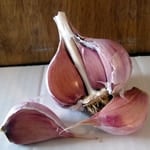
October through December, depending on your climate, is the time of year to plant garlic. The cloves are tucked into their soil beds for the winter and are able to establish their root system early in their growth process. Their green shoots will appear in early spring, or earlier if you live somewhere with mild winters. Garlic bulbs are harvested in summer, when some of the leaves have turned brown, but 5 or 6 green leaves remain. Finding seed garlic from a source near you is to your advantage, as garlic acclimates to its surroundings, but experimenting with different varieties of garlic is fun and the only way you'll know what works in your particular situation!
Garlic is highly adaptable and can be grown almost anywhere in North America, although ideal soil and climate do give the garlic grower an advantage.
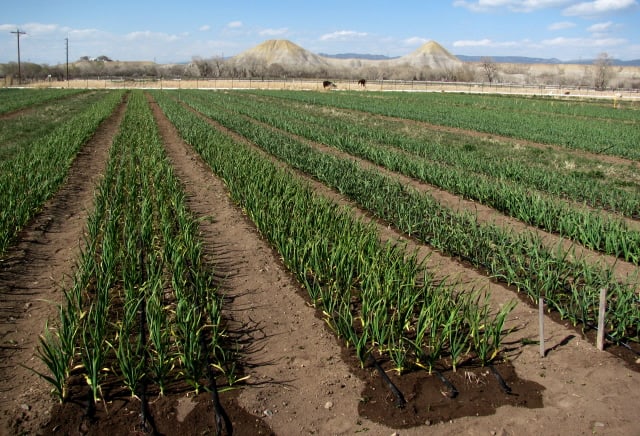
There are two subspecies of garlic: hardneck (ophio) and softneck. Most hardneck varieties require a cold winter to produce bulbs of good size and quality. Hardneck garlics are generally characterized by a single circle of cloves surrounding a woody stalk and have between 4 and 10 easy-to-peel cloves, and intense flavor. They have a shorter storage life than softneck varieties.
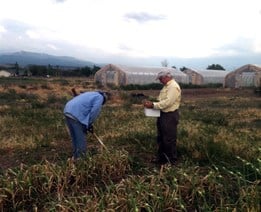
Softneck garlics do not need a cold winter to do well, and they can tolerate a wide range of climates and soils. Softneck bulbs can grow quite large and produce 8 to 40 cloves each, but do not have as intense flavor as hardneck garlics.
Garlic is a "survivor" and can grow in less than perfect soils, but planting it in fertile, well-drained garden soils will yield the largest, cleanest bulbs. Planting plump cloves from 2 - 2 1/2 inch bulbs will increase your probability of harvesting large bulbs. Large bulbs of that size growers refer to as "seed garlic". To plant, bulbs are separated into individual cloves and cloves are planted with pointed ends up, scab (root) ends down. We recommend planting only medium and large size cloves. The small ones you can eat or use in your next culinary delight. Push the clove into the ground at a depth of about 3 inches (although this varies among growers due to climate), and cover with soil. We plant each clove six inches apart, in rows which are six inches apart. A moderately light mulch can be applied.
Once the garlic has sprouted it's green leaves it needs adequate moisture for maximum growth. It can be watered on the same schedule used for most leafy green vegetables. We use drip tape for irrigation and place one row of drip tape between two rows of garlic. Too much water in late spring, early summer, will increase the risk of diseases, molds, and stained bulb wrappers. We usually stop irrigating two weeks before harvest.
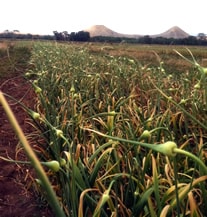
Garlic should be harvested when 5 or 6 green leaves still remain. Each of these leaves provides a wrapper for the bulb, and if the leaves have all turned brown and dry, the bulb will not have it's protective layers which help to maintain integrity in storage. The bulb should be carefully removed from the ground, keeping the stalk intact. We tie our garlic with string and hang it to dry, in bunches of six. It needs to dry in a place with good airflow and out of direct sun. When all the leaves are crisp and brown, they can be cut off, leaving a neck of at least one inch. The roots are then trimmed and soil can be carefully removed.
When storing garlic, keep it in a well ventilated space and open container. Closed air tight containers will make your garlic spoil faster. A cool, dry, and dark place is ideal. Store it out of any direct sunlight to inhibit any growth.
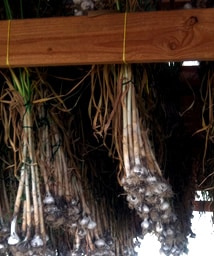
Soft neck garlic bulbs will survive longer than your hard neck garlics. Don’t store it together. Hard necks will tend to spoil faster within 4 months while the soft necks can survive up to 6-8 months. You don’t want your soft necks getting contaminated by the hard necks. This will allow you to have garlic on hand for eating year round and also have seed stock for the following years' planting.
This article provides you with just the very basics of growing garlic. If you are interested in learning more about it, we highly recommend the book Growing Great Garlic: The Definitive Guide for Organic Gardeners and Small Farmers by Ron Engeland. If you have questions about garlic, or want to purchase garlic for planting, or eating, feel free to call us or check our website.
Enjoy planting your next patch of garlic. - Karen
Chet and Karen Byler are certified organic garlic farmers on the beautiful, high-desert valley of Montrose County, Colorado. Straw Hat Farm is a small, family-owned and operated farm that grows and sells many varieties of vegetables and produce, but specialize in organic, gourmet garlics. The sell both table and seed garlic as well make garlic powder and granules.
This What Should I Do? blog series is intended to surface knowledge and perspective useful to preparing for a future defined by Peak Oil. The content is written by PeakProsperity.com readers and is based in their own experiences in putting into practice many of the ideas exchanged on this site. If there are topics you'd like to see featured here, or if you have interest in contributing a post in a relevant area of your expertise, please indicate so in our What Should I Do? series feedback forum.
If you have not yet seen the other articles in this series, you can find them here:
- Vermiculture: Getting down and dirty with worms (jasonw)
- Starting your investment plan (Travlin)
- Getting In Shape: The New Me (cmartenson)
- Slow Money: Getting the “Numb” Out of Numbers (woodytasch)
- Preserving Meat By Curing and Smoking (DanJab)
- Raising Children in Changing Times (DianneM)
- Argentina: A Case Study in How An Economy Collapses (FerFAL)
- Wood Gasification: An Intriguing Emergency Fuel Source (Dutch John)
- Whole Food Eating (Teresa Piro)
- The Case for Small Scale Biofuels (Ready)
- Preparing for Economic Collapse (FerFAL)
- Buying a House in Today's Market (Patrick Killelea)
- How To Increase The Energy Efficiency of Your Existing Home (zeroenergy21)
- Fortifying Yourself And Your Home Against Crime (thc0655)
- Food Storage Made Easy (Adam)
- Quick Primer on Contamination Control Measures (Dogs_In_A_Pile)
- Practical Survival Skills 101 - Understanding Emergencies (Aaron Moyer)
- How to Explain the Current Economic Situation to Friends & Family (rhare)
- Managing Pain Without Meds (JAG)
- Protecting Yourself Against Crime and Violence (thc0655)
- Cultivating Inner Resilience in the Face of Crisis (suziegruber)
- Problem Solving: Improvise, Adapt, Overcome (Mooselick7)
- Extending the Harvest in Your Home Garden (Woodman)
- Practical Survival Skills 101 - Obtaining Shelter (Aaron Moyer)
- Woodworking (bklement)
- Making Soap (maceves)
- Small-Scale Beekeeping (apismellifera)
- Practical Survival Skills 101 - Water (Aaron Moyer)
- Prepping on a Shoestring (Amanda)
- Making the Urban-to-Rural Transition (joemanc)
- Dealing With a Reluctant Partner (Becca Martenson)
- Raising Your Own Chickens (Woodman)
- Practical Survival Skills 101 - Fire Starting (Aaron Moyer)
- A Quiet Revolution in Bicycles: Recapturing a Role as Utilitarian People-Movers - Part 2 (Cycle9)
- A Quiet Revolution in Bicycles: Recapturing a Role as Utilitarian People-Movers - Part 1 (Cycle9)
- The Keys to Transitioning Healthcare: Empowerment, Education, & Prevention (suziegruber)
- Installing A Solar Energy System (rhare)
- The Essential Gardening and Food Resilience Library (Old Hippie)
- Creating Healthy Snacks from Your Garden (EndGamePlayer)
- Peak Certainty, Food Resilience, and Aquaponics (Farmer Brown)
- A Case Study in Creating Community (SagerXX)
This series is a companion to this site's free What Should I Do? Guide, which provides guidance from Chris and the PeakProsperity.com staff on specific strategies, products, and services that individuals should consider in their preparations.
This is a companion discussion topic for the original entry at https://peakprosperity.com/the-basics-of-growing-garlic-2/
